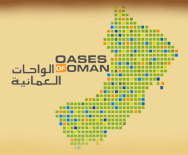 |
| Overview |
| Al Jabal al Akhdar |
| Balad Seet Wadi Tiwi & Maqta |
 |
Overview - Geography, climate and settlement history of Oman
Geography The land area of Oman shows varying topographic features: valleys and desert account for 82 % of the land mass; mountain ranges for 15 %; and the coastal plain for 3 %. Natural features divide the country into seven distinct areas: Ruus al Jibal, including the northern Musandam Peninsula; the Al Batinah coastal plain; the Muscat-Matrah coastal area; the Oman interior, comprising Al Jabal- al-Akhdar (Green Mountain), its foothills, and desert fringes; the barren coastline south to Dhofar; Dhofar region in the south; and the offshore island of Masirah. The Al-Hajar Mountains form two ranges, the Al-Hajar al Gharbi Mountains (western part) and the Al-Hajar ash Sharqi Mountains (eastern part). They are divided by the Wadi Samail, the largest wadi in the mountain zone, which forms the traditional route between Muscat and the interior. The general elevation is about 1,200 meters, but the peaks of the high ridge Jabal-al-Akhdar (Green Mountain) rise to more than 3,000 meters. A part of Jabal al-Akhdar was declared as national park. Climate With an average annual precipitation of 55 mm and a potential evapotranspiration of more than 2000 mm yr-1 the. Sultanate is effected by extremely arid climate conditions. Only the Dhofar region has a light monsoon climate and receives cool winds from the Indian Ocean. Thus the country's agriculture depends completely on irrigation. The area equipped for irrigation was reported to be 61 550 ha in 1993, equivalent to about 0.2% of Oman's total land surface. In the Al-Hajar Mountains the winters are cool and the night temperature can drop below 0 °C in January and February, sometimes with snow. Precipitation can be up to several hundred mm, but the mountains are bare without vegetation. During the summer there is no precipitation and the day temperatures can climb up to 30 °C and more. The nights can be very chilly though. Settlement History Until the discovery of oil and natural gas, the livelihood of the population was based on seafaring, fishing, livestock breeding and farming. Limited by eytremly small and irregular yearly percipitation in the catchment area of the mountains, a complex irrigation system developed over 3000 years ago and formed a typical oasis culture. The earliest oasis settlement in this region is thought to be Hili in the modern oasis of Al Ain in the United Arab Emirates, which was dated to the early 3rd millennium BC (Cleuziou 1998; Costantini1980). It was concluded from charred date stones and imprints of barley, wheat and sorghum in dried mud found at this place, that it had already at this early time a well-organized oasis agriculture. Since the Umm an-Nar period many other oasis settlements were established at the eastern and western coast of the Oman Peninsula as well as at thensouth-western and southern foreland of the Hajar mountains. For the Iron Age II period between 1,100 and 600 BC, a dramatic rise in the number of settlements has been documented, as well as a shift of settlements from the mountain foreland towards the mountainous regions (Magee 1999). Since many of the new established villages were situated very close to traditional falaj systems, it seems reasonable to explain the development of oases with the introduction of this intrinsic method of irrigation. Recent changes As a result of the oil boom of the 70´s and 80´s, a so called oil urbanization began. Within a short time rapid cultural, social, and economic changes took place. The country has experienced a development in 30 years which in other regions has taken sometimes 200 years. Today, a quarter of Oman’s 2.5 million inhabitants (Ministry of Information 2004 (data for 2003 for Muscat); Worldbank 2004 (data for 2002 for Oman)) live in the country’s capital Muscat. Traditionally, however, such large cities did not exist in Oman. A large number of traditional settlements have been abandoned.
|